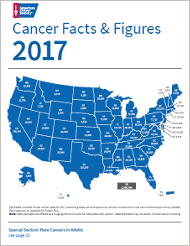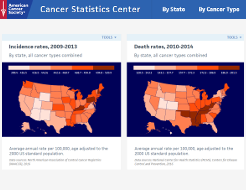Cancer Facts & Figures 2017
Note: This is not the most recent information. Please visit cancer.org/statistics to access the current version of Cancer Facts and Figures.

This annual report provides the estimated numbers of new cancer cases and deaths in 2017, as well as current cancer incidence, mortality, and survival statistics and information on cancer symptoms, risk factors, early detection, and treatment. In 2017, there will be an estimated 1,688,780 new cancer cases diagnosed and 600,920 cancer deaths in the US. (Please note: The projected numbers of new cancer cases and deaths in 2017 should not be compared with previous years to track cancer trends because they are model-based and vary from year to year for reasons other than changes in cancer occurrence. Age-standardized incidence and death rates should be used to measure cancer trends.)
Cancer Facts & Figures 2017 is accompanied by Cancer Statistics 2017, a scientific paper published in the American Cancer Society journal, CA: A Cancer Journal for Clinicians.
Cancer Facts & Figures 2017 Special Section: Rare Cancers in Adults
In 2017, nearly 13% of all cancers diagnosed in adults ages 20 and older will be rare cancers, defined in this report as a cancer with fewer than 6 cases per 100,000 people per year. This year’s special section reviews statistics for 28 rare cancers, including incidence and mortality rates and trends, stage at diagnosis, and survival, and also provides an overview of risk factors and symptoms for select cancers. It is intended to inform anyone interested in learning more about rare cancers in adults, including policy makers, researchers, clinicians, cancer control advocates, patients, and caregivers. (Childhood and adolescent cancers are reviewed in the special section of Cancer Facts & Figures 2014.)
Cancer Facts & Figures 2017 Supplemental Data
This supplemental data set provides the estimated numbers of new cancer cases and deaths in 2017 by state for 21 cancer sites and by age group for the four major sites (lung, breast, colorectum, and prostate). Also included is the lifetime probability of developing and dying from cancer for 23 cancer types. These data can be used as a resource for cancer control planning at the state level, as well as to address questions from the media or constituents. Divisions are encouraged to share this information with staff and volunteers, and to use it with state and local officials, reporters, and other public health and advocacy groups in local communities.
- Estimated New Cases for the Four Major Cancers by Sex & Age Group, 2017 (PDF)
- Estimated Deaths for the Four Major Cancers by Sex & Age Group, 2017 (PDF)
- Estimated New Cases & Deaths by State for 21 Cancer Sites, 2017 (PDF)
- Lifetime Probability of Developing & Dying from Cancer for 23 Sites, 2011-2013 (PDF)
Downloadable Data
Download key cancer trend data from Cancer Facts & Figures 2017. Please note that all material using this data should credit the "American Cancer Society, Cancer Facts & Figures 2017."
- Trends in Age-adjusted Cancer Death Rates by Site, Males, US, 1930-2014 (EXCEL)
- Trends in Age-adjusted Cancer Death Rates by Site, Females, US, 1930-2014 (EXCEL)
Most Requested Tables and Figures
The most requested tables and figures from Cancer Facts & Figures 2017 have been assembled in an electronic format (PDF) to make it easy for you to use them. Please note that all graphic material should credit the "American Cancer Society, Cancer Facts & Figures 2017.”
- Trends in Age-adjusted Cancer Death Rates by Site, Males, US, 1930-2014 (PDF)
- Trends in Age-adjusted Cancer Death Rates by Site, Females, US, 1930-2014 (PDF)
- Estimated Number of New Cancer Cases and Deaths by Sex, US, 2017 (PDF)
- Estimated Number of New Cases for Selected Cancers by State, US, 2017 (PDF)
- Estimated Number of Deaths for Selected Cancers by State, US, 2017 (PDF)
- Leading Sites of New Cancer Cases and Deaths - 2017 Estimates (PDF)
- Probability of Developing Invasive Cancer During Selected Age Intervals by Sex, US, 2011-2013 (PDF)
- Incidence Rates for Selected Cancers by Race and Ethnicity, US, 2009-2013 (PDF)
- Death Rates for Selected Cancers by Race and Ethnicity, US, 2010-2014 (PDF)
- Geographic Patterns in Lung Cancer Death Rates by State, US, 2010-2014 (PDF)
Cancer Statistics 2017 Slide Presentation
The following presentation provides an overview of current cancer statistics in the US.
Interactive Cancer Statistics Center

Visit the American Cancer Society’s Cancer Statistics Center website to explore, interact with, and share cancer statistics.



